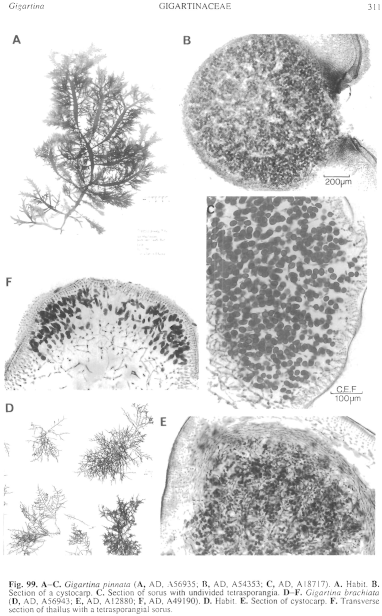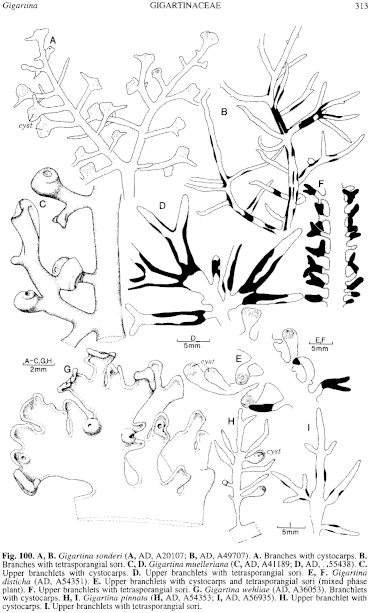|
|
|
|
|
|||||||||||
|
Electronic Flora of South Australia Species Fact Sheet
Phylum Rhodophyta – Class Florideophyceae – Order Gigartinales – Family Gigartinaceae
Selected citations: Setchell & Gardner 1933: 294; 1934: 136.
Synonym
Gigartina lanecata J. Agardh ex Wilson 1892: 183 (nomen nudum).
Thallus (Fig. 99A) dark red to brown-red, fading to yellow-brown, 15–30 cm high, drying cartilaginous, with one to a few fronds from the holdfast; fronds complanately branched, alternately pinnate from close to the base, branching distant to dense, with percurrent axes (3–) 5–15 mm broad, 0.7–1.5 mm thick, broader axes often with surface proliferations; marginal laterals similarly pinnate, 2–5 (–10) mm broad and 250–500 µm thick, with pinnules 1–20 mm long and 1–3 mm broad, compressed, basally constricted and with rounded apices; older axes often with compressed surface ramuli 2–12 mm long, simple or branched. Holdfast discoid, 1–4 mm across; epilithic. Structure of a dense cortex of anticlinal, subdichotomous, filaments, end cells 1–2 µm in diameter and L/D 2–4, and a medulla of anastomosing filaments 4–12 µm in diameter.
Reproduction: Sexual thalli monoecious. Carpogonial branches 3-celled, borne on inner cortical (supporting) cells in the ultimate pinnules. Cystocarps (Fig. 100H) 1–1.5 mm across, subterminal in compressed pinnules with a rounded (rarely spinous) end, with a depressed cortex and without involucral ramuli; enveloping tissue compact, without transverse filaments but some inner cells connected to gonimoblast cells, carposporophyte (Fig. 99B) with a filamentous matrix and clusters of ovoid carposporangia 12–20 µm in diameter. Spermatangial sori surrounding developing cystocarps, with the outer cortical cells each cutting off two initials which produce ovoid spermatangia about 1 µm in diameter.
Tetrasporangial sori (Fig. 100I) ovoid to linear, mainly on the margins of compressed ramuli, (0.5–) 2–8 (–10) mm long and 0.5–1 mm broad, with tetrasporangia (Fig. 99C) primarily transformed from or cut off laterally from outer medullary cells, ovoid, (15–) 20–30 µm in diameter, cruciately divided.
Mixed phase plants sometimes occur, with cystocarps and tetrasporangia on the same plant.
Type from Port Phillip, Vic. (misit Malm); holotype in Herb. Agardh, LD, 23536.
Selected specimens: Wanna, S. Aust., drift (Womersley, 19.ii.1959; AD, A22378). Pondalowie Bay, S. Aust., 20 m deep (Edyvane, 2.iv.1983; AD, A54353). Port Elliot, S. Aust., drift (Womersley, 23.v.1953; AD, A18717). Robe, S. Aust., drift (Womersley, 15.iv.1959; AD, A23003). Blackfellows Caves (S of Carpenter Rocks), S. Aust., 13.5 m deep 1 km offshore (Edyvane, 27.ix.1982; AD, A57057). Middle Point, Cape Northumberland, S. Aust., 15 m deep 1.3 km offshore (Shepherd, 13.ii.1976; AD, A47013). Port MacDonnell, S. Aust., drift (Edyvane, 16.ii.1985; AD, A56935). Glenelg R. mouth. Vic., drift (Beauglehole, 22.i.1950; AD, A15687). Fluted Cape, Bruny I., Tas., 23 m deep (Shepherd, 12.ii.1972; AD, A41911).
Distribution: Wanna, S. Aust., to Port Phillip Heads, Vic., and the E coast of Tasmania, in deep water on rough-water coasts.
Taxonomic notes: G. pinnata is very similar to Sarcothalia crassifolia in form, but differs in having marginal, elongate, shallow tetrasporangial sori, with the tetrasporangia largely derived from outer medullary cells, in contrast to the maculate, deeper situated, sori on the flat surface of the latter, where clusters of inward-growing mid medullary filaments form the tetrasporangia. Cystocarpic plants of G. pinnata do not possess involucral ramuli around the cystocarps and have few if any transverse filaments passing through the enveloping tissue. G. pinnata is also a deeper water species compared to the just subtidal S. crassifolia.
G. lanecata is a manuscript name of J. Agardh and specimens from Port Phillip Heads, Vic. (Wilson, 10.iv.1890; 8.i.1894; 28.i.1895; MEL, 652109, 652110, 652108 resp.) in MEL are a laxly branched form of G. pinnata.
References:
AGARDH, J.G. (1851). Species Genera et Ordines Algarum. Vol. 2, Part 1, 1–336 + index. (Gleerup: Lund.)
AGARDH, J.G. (1876). Species Genera et Ordines Algarum. Vol. 3, Part 1 - Epicrisis systematis Floridearum, pp. i-vii, 1–724. (Weigel: Leipzig.)
SETCHELL, W.A. & GARDNER, N.L. (1933). A preliminary survey of Gigartina, with special reference to its Pacific North American species. Univ. Calif Pubis Bot. 17, 255–340.
SETCHELL, W.A. & GARDNER, N.L. (1934). De Gigartinis. Rev. Algol. 7, 131–138.
WILSON, J.B. (1892). Catalogue of algae collected at or near Port Phillip Heads and Western Port. Proc. R. Soc. Vict. 4, 157–190.
The Marine Benthic Flora of Southern Australia Part IIIA complete list of references.
Publication:
Womersley, H.B.S. (14 January, 1994)
The Marine Benthic Flora of Southern Australia
Rhodophyta. Part IIIA, Bangiophyceae and Florideophyceae (to Gigartinales)
Reproduced with permission from The Marine Benthic Flora of Southern Australia Part IIIA 1994, by H.B.S. Womersley. Australian Biological Resources Study, Canberra. Copyright Commonwealth of Australia.
Illustrations in Womersley Part IIIA, 1994: FIGS 99 A–C, 100H, I.

Figure 99 enlarge
Fig. 99. A–C. Gigartina pinnata (A, AD, A56935; B, AD, A54353; C, AD, A18717). A. Habit. B. Section of a cystocarp. C. Section of sorus with undivided tetrasporangia. D–F. Gigartina brachiata (D, AD, A56943; E, AD, Al2880; F, AD, A49190). D. Habit. E. Section of cystocarp. F. Transverse section of thallus with a tetrasporangial sorus.

Figure 100 enlarge
Fig. 100. A, B. Gigartina sonderi (A, AD, A20107; B, AD, A49707). A. Branches with cystocarps. B. Branches with tetrasporangial sori. C, D. Gigartina muelleriana (C, AD, A41189; D, AD, .55438). C. Upper branchlets with cystocarps. D. Upper branchlets with tetrasporangial sori. E, F. Gigartina disticha (AD, A54351). E. Upper branchlets with cystocarps and tetrasporangial sori (mixed phase plant). F. Upper branchlets with tetrasporangial sori. G. Gigartina wehliae (AD, A36053). Branchlets with cystocarps. H, L Gigartina pinnata (H, AD, A54353; I, AD, A56935). H. Upper branchlet with cystocarps. I. Upper branchlets with tetrasporangial sori.

|
Email Contact: State Herbarium of South Australia |

|